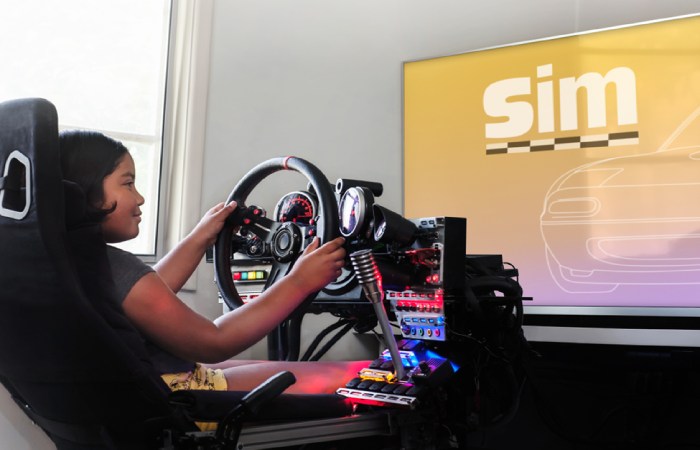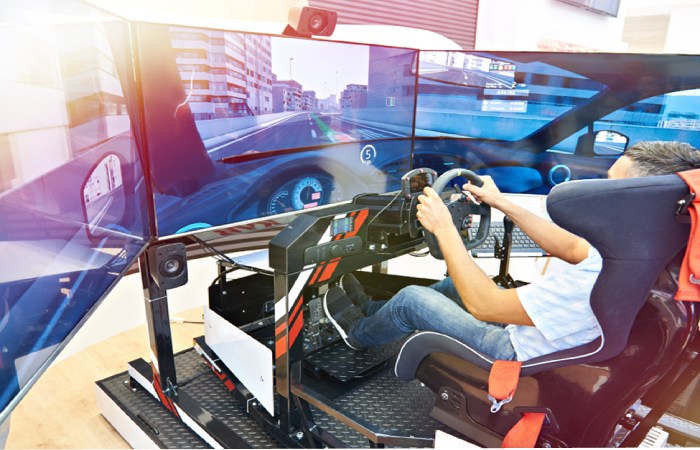The racing video game genre has over 50 years of rich history, dating to Atari’s Space Race in 1973. Since then, racing games have developed into various sub-genres and featured numerous vehicles and settings, including karts, real-life cars, motorcycles, trucks, and fictional machines.
One of the most common ways to categorize racing games today is using the arcade vs. simulation scale. Arcade racing games are frequently compared to realistic racing simulators, and many games fall on either end or in the middle of the scale. Each provides different gaming experiences that appeal to players of different tastes and backgrounds.
Here’s a brief breakdown of the difference between arcade racers and sim-racing titles, where the latest titles fall on the scale, and how to determine which is more fun for you.
Table of Contents
What Is an Arcade Racing Game?
In the past and until the late ’90s to early 2000s, the term arcade racing games primarily referred to the racing games featured in the actual arcades. As with many other video games at the time, arcade racers offered more visually impressive and technologically advanced video gaming experiences than home consoles and computers.
Notable arcade racing games of the past include Virtua Racing, Daytona USA and its sequel Daytona USA 2, Sega Rally, Ridge Racer, Hang-On, and San Francisco Rush 2049. Many popular titles were licensed and based on other intellectual properties, such as Star Wars: Racer Arcade or Initial D Arcade Stage. Others focus on unique driving experiences instead of pure racing, such as OutRun and Crazy Taxi.
Arcade Racing Games Today
While the era of arcades faded when home consoles could provide equal or better processing power than dedicated arcade machines, the arcade racing genre has never disappeared. Newer, more modern arcade racers built upon the tropes of their arcade cabinet predecessors. Although each game is unique, the typical arcade racer can be distinguished from other, more realistic titles with these broad characteristics:
- Easy to pick up, hard to master. Just like their predecessors, modern arcade racers are, first and foremost, designed with accessibility in mind with simple, uncomplicated controls. However, the best arcade racers often feature mechanics that enhance their depth and reward skillful play. For example, systems like drifting, power-sliding, nitro boosts, and power-up items can give players an edge and secure first place more easily when mastered.
- Style and presentation. Arcade racers often feature bright, inviting environments that prioritize visual style and art direction over replicating real-world locales or realistic environments.
- Wider range of vehicles and settings. Unlike simulators, which mainly replicate real-world cars, arcade racers can feature various vehicles, including fictional or unrealistic ones. Karts, in particular, were popularized by the original Mario Kart and have spawned an entire sub-genre of racing games known as kart racers.

What Is a Racing Simulator?
Racing simulators are primarily concerned about accurately simulating vehicles, often in a racing environment with the correct rules and mechanics. While they are still video games, the exact degree to which a sim racing game focuses on the gameplay experience varies.
While games attempting to simulate racing with some realism have existed in the arcades since Namco’s Pole Position in 1982, the term was popularized by home releases. Indianapolis 500: The Simulation, a 1989 PC game developed by Papyrus, is widely credited as the first PC sim racer.
On consoles, the simulation racing genre remained unheard of until the release of the original Gran Turismo on PlayStation in 1996. Gran Turismo became one of the best-selling PlayStation franchises ever, demonstrating that simulation racers have a broader appeal than initially believed.
The more advanced a racing simulator is, the closer it mimics the physics and behavior of its real-world equivalents, and the more real-world knowledge is required to master them. The most competitive drivers can even use them to practice driving in a safe, virtual environment before tackling the real-world track. This approach has become an industry standard. The world’s top racing drivers, such as Max Verstappen, use dedicated, factory-designed simulators to practice their racecraft.
Today’s Racing Simulators
Racing simulators today distinguish themselves from other racing game titles in three main ways:
- Realistic physics and handling. The most important aspect of a racing simulator is its fidelity and accuracy to the real world. This rule applies whether the game is designed to emulate hundreds of different cars, such as Assetto Corsa and iRacing, or a single race car category, such as GT3s in Assetto Corsa Competizione or Formula Ones in F1 2023.
- Dedicated hardware is key to success. Investing in a racing simulator setup is highly recommended to be as competitive as possible. While many sim racers support controllers, a setup comprising a racing wheel and pedals is the minimum investment required to get the best lap times and the most control over your vehicle.You can use a racing sim builder to craft the perfect combination of stand, racing seat, wheel, and pedals. Consider accessories like manual shifters and handbrakes for a more realistic feel.
- Real-world skills transfer to the sim. If you have skills driving or racing real-world cars, many of these skills will transfer over to the simulator. This is especially true if you have experience in the same cars or on the same circuits displayed in the game.The reverse also applies. Becoming a skilled driver in a racing sim is known to translate to the real world. A real-world example is Jann Mardenborough, who transitioned from a Gran Turismo sim racer to a professional racing driver in Super GT, the FIA World Endurance Championship, and the 24 Hours of Le Mans.
Simcade: The Middle of the Scale
Some sim racers are referred to as “simcade” titles. While there is no generally accepted definition of the term, simcade titles typically blend racing sim and arcade elements to create a compelling gaming experience. Racing game franchises commonly described as simcade include Gran Turismo, Forza Motorsport, Forza Horizon, and GRID.
For example, a simcade title typically features real-world cars with realistic specifications, driving physics, and support for racing wheels. At the same time, they may abstract or omit some aspects typical of a simulator, such as damage and fuel management, or introduce arcade game elements, such as party modes or stunt driving.

Which Type of Racing Game Is Right for You?
While arcade, sim, and simcade games can all be fun, the best type of racing game for you depends on your preferences in gaming.
If you primarily seek an easily accessible experience delivering quick bursts of fun and compatibility with standard peripherals, games closer to the arcade side of the scale might be better suited for you.
On the other hand, if you are interested in real-world cars, driving, and motorsport, or if you enjoy the most realistic and immersive experience, it may be worth investing in a racing wheel and choosing a racing simulator. Simcades stand in the middle, offering a compromise between the two and serving as an accessible introduction to more realistic forms of racing.

